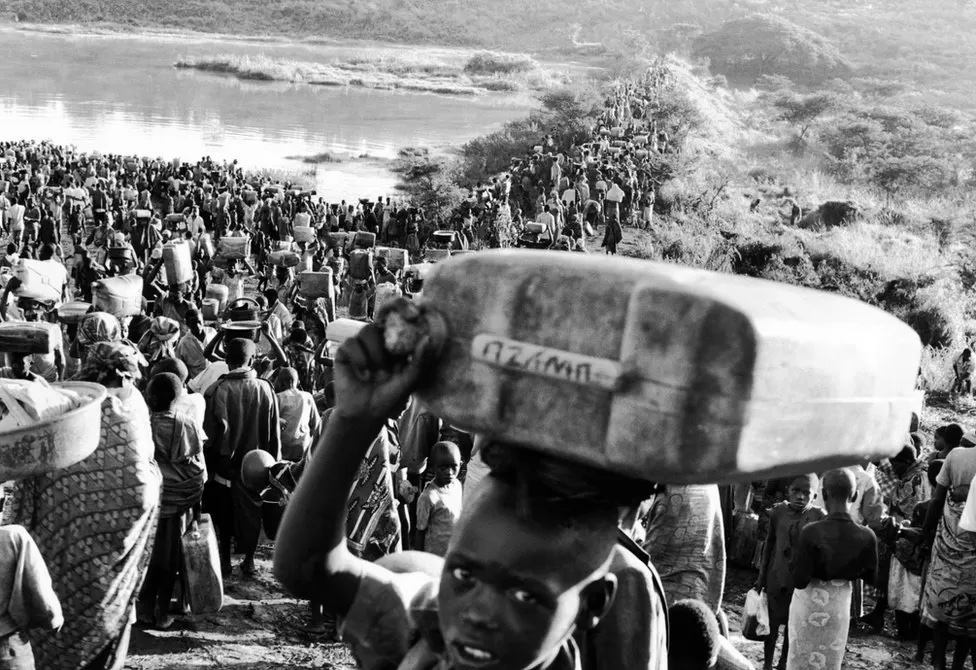- About Ramapo
- Academics
- Admissions & Aid
- Student Life
- Athletics
- Alumni
- Arts & Community
- Quick Links
- Apply
- Visit
- Give
Kwibuka 30, Panel 1
Hutus Fleeing to the Democratic Republic of Congo (then Zaire)
Hutu and Tutsi: A Casualty of Colonialism
Following the journeys of German explorer Gustav Adolf von Gotzen, Rwanda would become one of the primary colonies of German East Africa. With the treaty of Versailles, it fell to Belgium, which desired to control its rubber, minerals, and agricultural products. At the point of colonization, Rwandans were generally divided into three groups largely tied to class: Twa, Hutu, and Tutsi.
Belgium brought what had largely been a foreign concept to Rwanda, the idea of a racial hierarchy. Belgian colonial agents, combined their notions of racial hierarchy with an idea known as the Hamitic Myth. The narrative held that Tutsi—who led Rwanda’s monarchy—were from Northern Africa, while Hutu were indigenous to Rwanda. Essentially, they designated Tutsi as having greater proximity to whiteness as compared to Hutu, elevating them and enshrining their dominance in Rwanda colonial society. With the 1959 revolution and the installation of a Hutu Republic, Tutsi hatred became a hallmark of the new society, especially as Tutsi fled Rwanda en masse following the monarchy’s fall. Decades of division and hate towards the minority Tutsi, focused on the same physical characteristics used by the Belgians to elevate them, culminated in the 1994 genocide. Extremist Hutu justified violence against Tutsi by pointing to the actions by the Rwandan Patriotic Front—largely comprising Tutsi who had fled with the fall of the Monarchy—notably accusing it of felling a plane carrying the Rwandan President. In response to this event, Hutu extremists initiated a genocide. In sum, the colonial period largely served to escalate and reshape underlying tensions and divisions within Rwandan society; establishing favoritism, mistrust, and cultivating hatred between Hutu and Tutsi.
Quick Links
Rwanda: A Brief History of the Country
What led to the genocide against the Tutsi in Rwanda?
Bibliography
Alluri, Rina M. “A History of Conflict: The Rwandan Civil War and Genocide.” The Role of Tourism in Post-Conflict Peacebuilding in Rwanda. Swisspeace, 2009.
Braeckman, Colette. 2021. “Belgium’s Role in Rwandan Genocide.” Le Monde Diplomatique. June 1, 2021.
Korman, Rémi. “The Tutsi Body in the 1994 Genocide: Ideology, Physical Destruction, and Memory.” In Destruction and Human Remains: Disposal and Concealment in Genocide and Mass Violence, edited by Élisabeth Anstett and Jean-Marc Dreyfus, 226–42. Manchester University Press, 2014.
Mamdani, Mahmood. When Victims Become Killers:Colonialism, Nativism, and the Genocide in Rwanda. Princeton University Press, 2019.
“The True Story of Tutsis and Hutus.” Tampa Bay Times, December 24, 1995.
Photo Source
BBC. “Africa’s Week in Pictures: 11-17 April 2014.” 2014. BBC News.
Copyright ©2025 Ramapo College Of New Jersey. Statements And Policies. Contact Webmaster.


Follow Us!